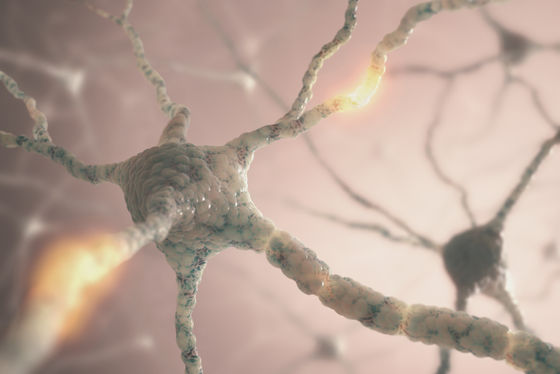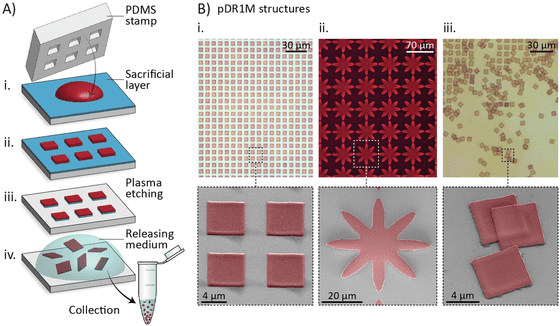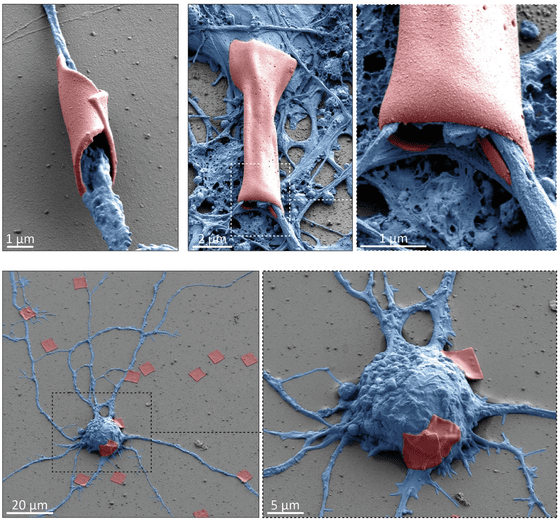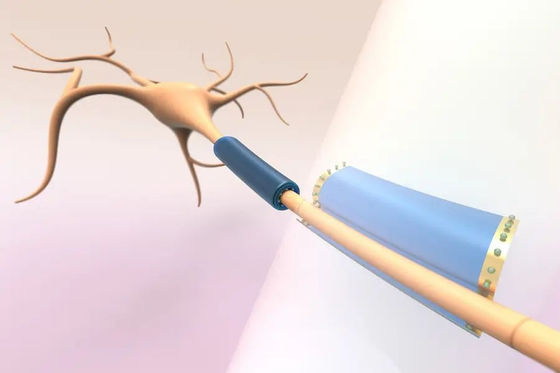MIT develops tiny film that protects nerves like insulating tape, with potential applications in neural interfaces to assist brain function

A research group at the Massachusetts Institute of Technology (MIT) in the United States has announced that it has developed a flexible thin-film material that can change shape when exposed to light and wrap around nerve cells and nerve fibers. This polymer film, which functions as an insulator, is promising for use in treating neurological diseases caused by neuronal damage, and in the future, it is expected that by incorporating circuits, it can function as a wearable device for neurons, and may be developed into wireless cybernetic technology that can monitor and regulate neural activity and restore lost neural functions.
Light-induced rolling of azobenzene polymer thin films for wrapping subcellular neural structures | Communications Chemistry
“Wearable” devices for cells | MIT News | Massachusetts Institute of Technology
https://news.mit.edu/2024/wearable-devices-for-cells-1031
MIT develops tiny devices to monitor and heal individual cells - restoring lost brain functions - The Brighter Side of News
https://www.thebrighterside.news/post/mit-develops-tiny-devices-to-monitor-and-heal-individual-cells-restoring-lost-brain-functions/
Researchers Create Cell-Level Wearable Devices to Restore Neuron Function - Neuroscience News
https://neurosciencenews.com/neuron-function-device-neurotech-27970/
For many years, scientists thought that nerve cells were the basic units of function in nervous tissues, such as the brain. However, recent advances in research have revealed that neurons function through the activity of subcellular compartments, such as the axon, dendrites and cell body.
Deepening our understanding of the functions of the individual parts that make up neurons and investigating the neuronal communication between individual cells could help us understand how the brain works and treat neurological diseases; however, neuronal tissue is complex, diverse, and delicate, which poses challenges.

This time, the MIT research group developed a thin film of a flexible polymer called Poly(Disperse Red 1 Methacrylate): pDR1M, which contains an organic compound called
Below is a schematic diagram of the manufacturing process of pDR1M film. pDR1M film is obtained by forming droplets of polymer solution on a sacrificial layer with a silicone material shaped like a mold, and dissolving the sacrificial layer. This manufacturing technique allows pDR1M film to be produced more cheaply and scalably than conventional methods that require semiconductor clean rooms.

Important properties of the pDR1M film are its flexibility, which allows it to encapsulate the complex structures of neurons without damaging them, and its ability to deform due to
This property allows the pDR1M film to wrap around and attach to cells when exposed to light, and the way the film fits to the cell can be precisely controlled by changing the intensity and direction of the light, as well as the shape of the film.

The research group has also succeeded in introducing pDR1M film into cultured rat neurons. According to the research group, the pDR1M film is extremely slow to biodegrade, and since isomerization does not occur unless exposed to light, it is unlikely to shift from its designated position.

It is envisioned that thousands of pDR1M films will be dissolved in solution, injected into the body, and then deformed by external light to encase neurons.
Its main use is in treating neurodegenerative diseases such as multiple sclerosis (MS), which are caused by the destruction of myelin , which protects the axons connecting neurons.
Azobenzene acts as an insulator, so if the pDR1M film is wrapped around axons in the same way that insulating tape is wrapped around an electrical wire, it could act as an artificial myelin to restore function to damaged neurons.

In the future, the film could be used to imprint circuit patterns onto sensors to monitor neuronal signals, or as wearable devices to regulate cell-level signals.

by Pablo Penso and Marta Airaghi
Related Posts:
in Science, Posted by log1l_ks







